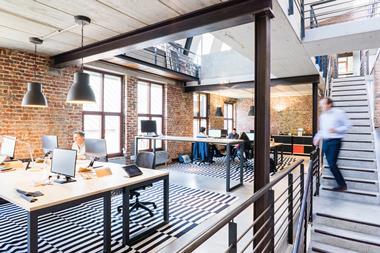Last week I wrote about the rate of progress in drone and electric aviation technology. It seems that autonomous ships are also on the horizon. In a few weeks’ time, history will be made when a boat departs from Plymouth to cross the Atlantic, relying on artificial intelligence and robotics and without a sailor on board.

The 15ft Mayflower Autonomous Ship will follow a similar route as the 17th century pilgrims, aiming to land at Plymouth, Massachusetts. How long until we see autonomous boats providing an alternative form of transport to move passengers and cargo up and down the Thames?
On the subject of technology and innovation, the recent ULI Europe Technology and Real Estate Council Meeting brought together some great tech minds. Thought-provoking presentations included one from Christina Black Petersen, founder of Lys Technologies.
The company, whose name derives from her Danish roots, (Lys is the Danish word for light) helps people live healthier lives by tracking the amount of natural light in their daily routines. Since we spend more than 90% of our time in artificial lighting and unhealthy indoor environments a lack of natural light can have a negative impact on sleep, work and wellbeing.
The company’s first innovation is a small wearable device that, once paired with a phone app, can improve the wearer’s light habits by tracking their light intake. The wearable tracks the light that users receive and provides personalised feedback and advice.
The device can also track, on an anonymised basis, how people move round buildings, and is therefore useful in improving design and layout to optimise wellbeing. The company have an extensive database on user light exposure extending to some 53 countries.
As a member of the Tech Council, I have received my wearable device to trial. This was not achieved without some difficulty. It may be indicative of the problems businesses are facing post Brexit, but my device failed to arrive, despite having been posted from Amsterdam some weeks before. The non-arrival was eventually explained in a letter from Parcelforce stating that, since the parcel had been sent from overseas, I had to pay import VAT and a clearance fee before it could be delivered. I duly paid the sum requested and the device finally arrived in the post, two minutes before our meeting.

It seems that a technology is not a universal panacea. Almost a year after Google-affiliated Sidewalk Labs parted ways with the city of Toronto, having pledged to make the city one of the world’s first smart cities, Toronto is embracing a very different vision of the future, in which affordability, sustainability and environmental design will be the priority. Whilst a data driven community seemed the future, there was push back against the need for surveillance cameras monitoring every movement and the harvesting of the data captured. Does the new vision reflect decreasing enthusiasm for technology’s role in community building and urban planning decisions?
This week my colleagues Ed Hughes-Power, Alex Rhodes and I hosted the second in our Mishcon Sustainability Circle series of debates. This session brought together experts in the world of real estate development to distil just some of the key issues around sustainability and the built environment. High on the agenda was the benefits of repurposing and adaptive reuse of existing buildings over new build. It became clear that this is a complex issue.
Developer U+I’s Martyn Evans commented, ‘it is your job to connect past and future and there is no better way of doing that than keeping buildings that are already there’. Ben Cross, development associate at General Projects added, ‘when you start to think about larger assets, larger buildings, and the embodied carbon that is essentially wasted in pulling them down and starting afresh, I think really the world is waking up to the fact that embodied carbon is just as important, if not more so than operational carbon.’ As another developer explained, ‘the bones of the building are the key to everything.
A completely open non-structural core creates far more long-term flexibility. When you do your whole life carbon analysis, if the bones of that building are poor, you can’t really repurpose it’.
The debate also highlighted the real risk of redundancy and ‘stranded assets syndrome’ of our existing property stock, especially when looked at through the lense of regulation and policy. For instance calls for, a VAT reduction on retrofit, have to date fallen on deaf ears. A clear overarching plan from government would be helpful.
A caveat was voiced around the danger of reducing the design life of existing buildings, that might have carried on for another 10 years. With pressure from funders to make sure buildings meet their ESG agenda, they may require refurbishment now although buildings may have had another 5 years or 10 years of life.
Central’s Patricia Brown stressed the importance of ‘having the education, the knowledge, the confidence and the leadership to give people what we know is right. This is a long term sustainable relationship that we are building rather than just plonking down, as Jan Gehl calls it, ‘a perfume bottle’ on a city and expecting everybody to love it because it’s a named architect’.
The debate underlined the significant opportunity developers have to enable beneficial change within local communities and how important it is to care about being tasked with this role.
Against the backdrop of this discussion, it was interesting to see that Marks and Spencer have announced plans to demolish and rebuild their flagship Marble Arch store on Oxford Street. Plans for this landmark building, which has been their home since 1930, include an additional four storeys, the scaling back of retail and an additional 300,000 sq ft of offices.
The façade of this building, along with the adjacent Selfridges façade are an important part of the Oxford Street story and serve to differentiate Oxford Street from other prime shopping streets in cities round the world. There may well be reasons for demolition and it could come down to ‘the bones of the building’ as noted above.
Marks & Spencer are also extending their online offer having greatly expanded the number of countries in which they will sell their clothes and homeware products. They have apparently launched 46 new websites, going far and wide, to include such places as Fiji, Argentina, South Korea, Nepal and Uzbekistan. It will be interesting to see how the British M&S brand fares in these new markets. Setting up a website is likely to be more cost effective than opening a store in these destinations to test the market.
In other retail news, a company backed by SoftBank that specialises in transforming under-used car parks and shopping centres into alternative uses such as urban farms, neighbourhood kitchens, fulfilment centres and e-scooter rental centres has agreed its first UK deal. Miami based Reef Technology, has signed a deal with London listed shopping centre owner, Capital & Regional. With retail occupation declining, all eyes will be on Reef’s platform of alternative uses as landlords consider how to adjust to an expected permanent shift towards online shopping and reduced demand for bricks-and-mortar retail.
Finally a note of caution to other pandemic pet boomers out there. UK supermarkets have warned of a shortage of some dog and cat food products following an ‘unprecedented’ rise in new pet ownership to counter lockdown loneliness. You may not have bargained on having to cook for little Fido but that may be on the cards.
Susan Freeman is a partner at Mishcon de Reya





























No comments yet